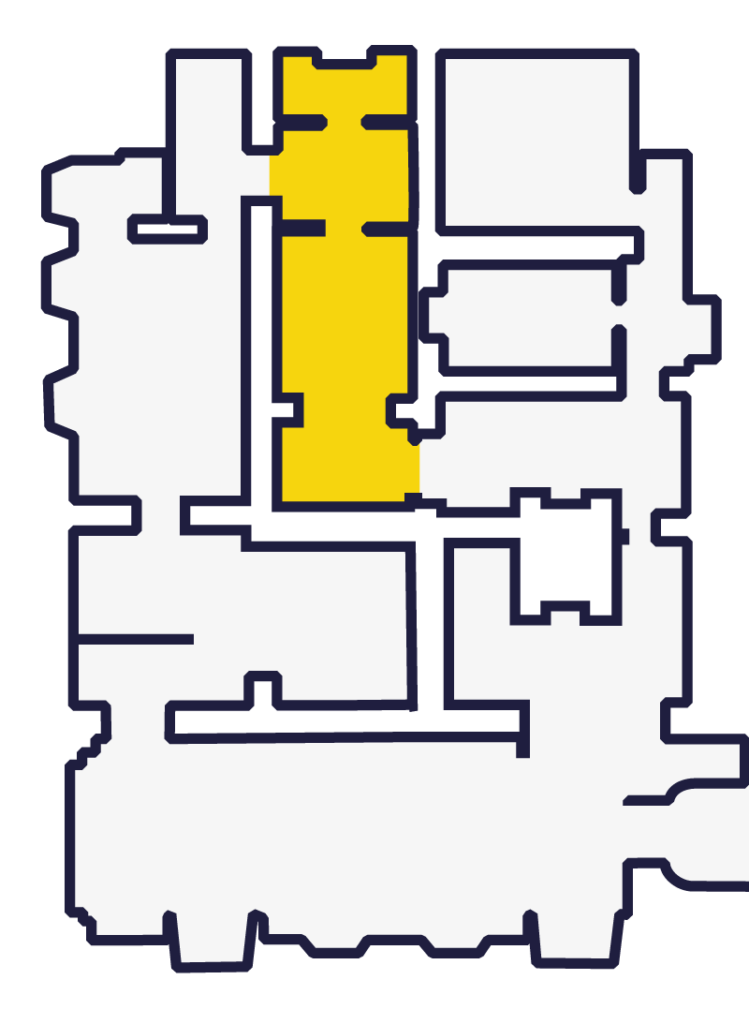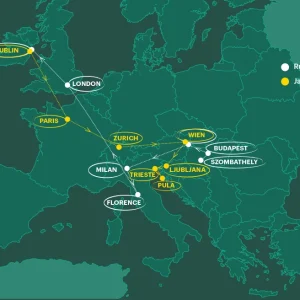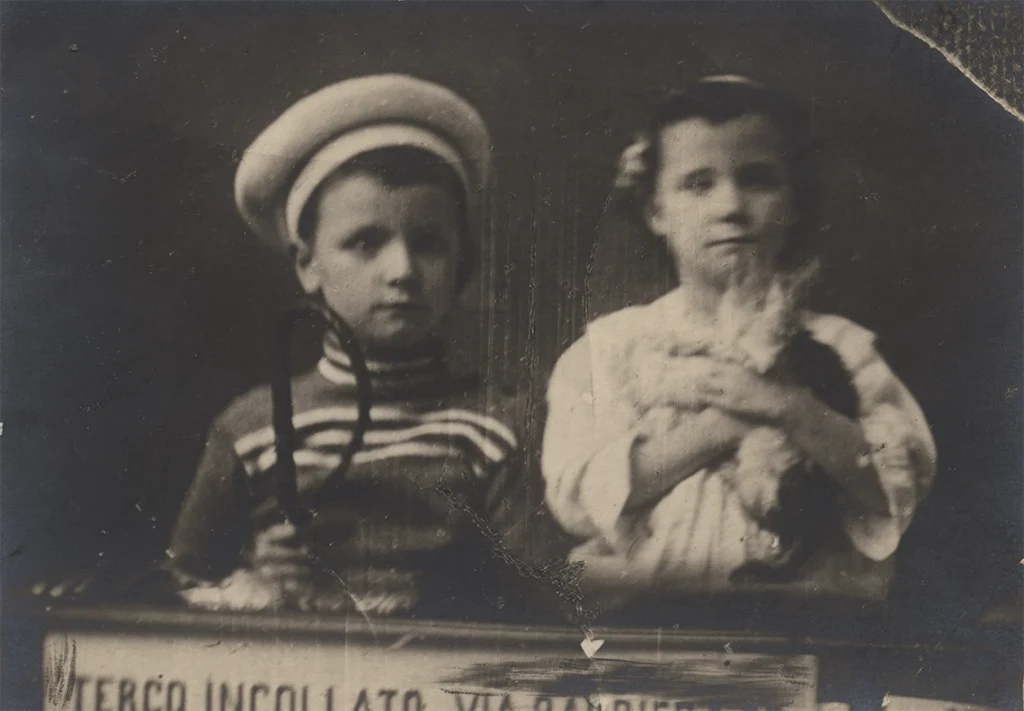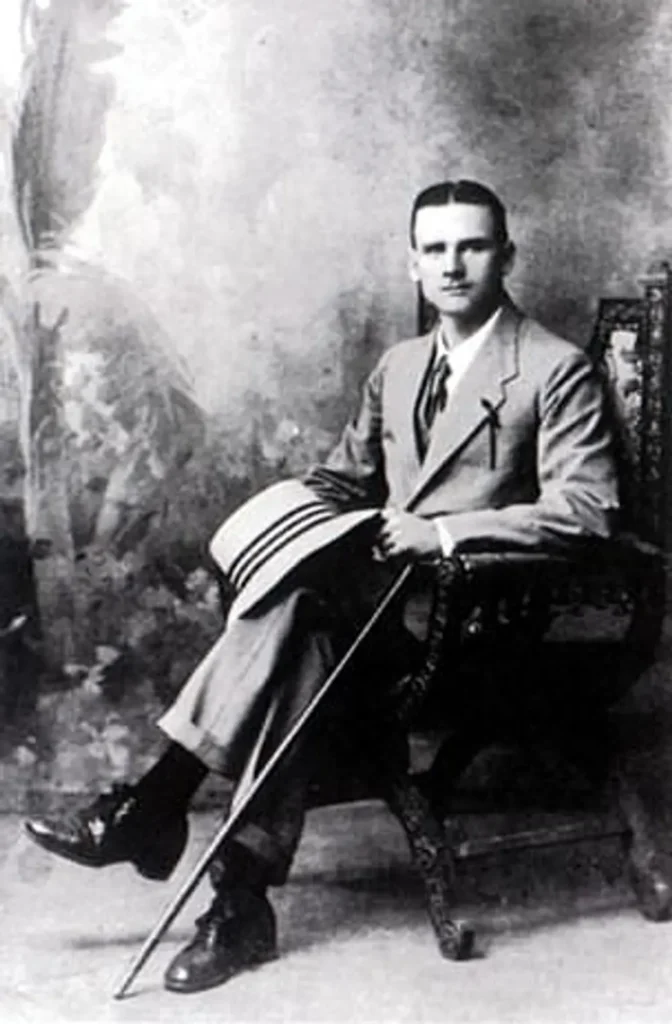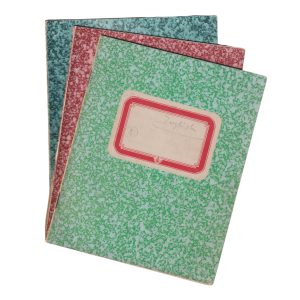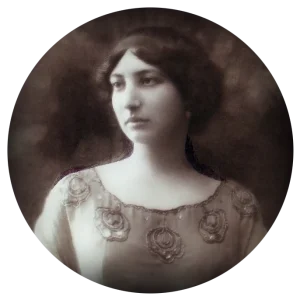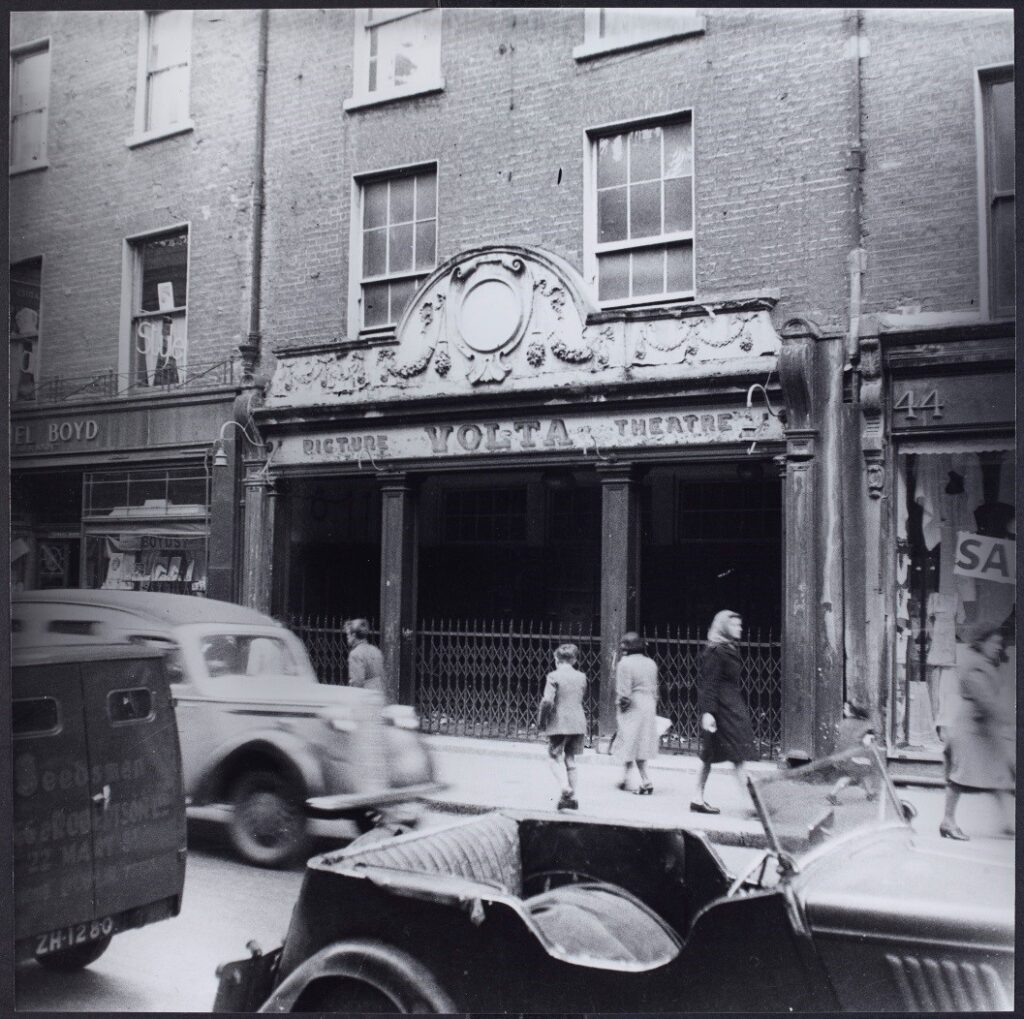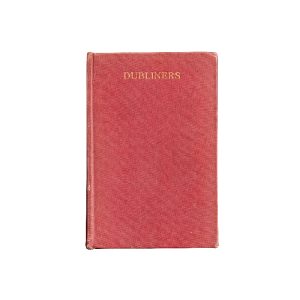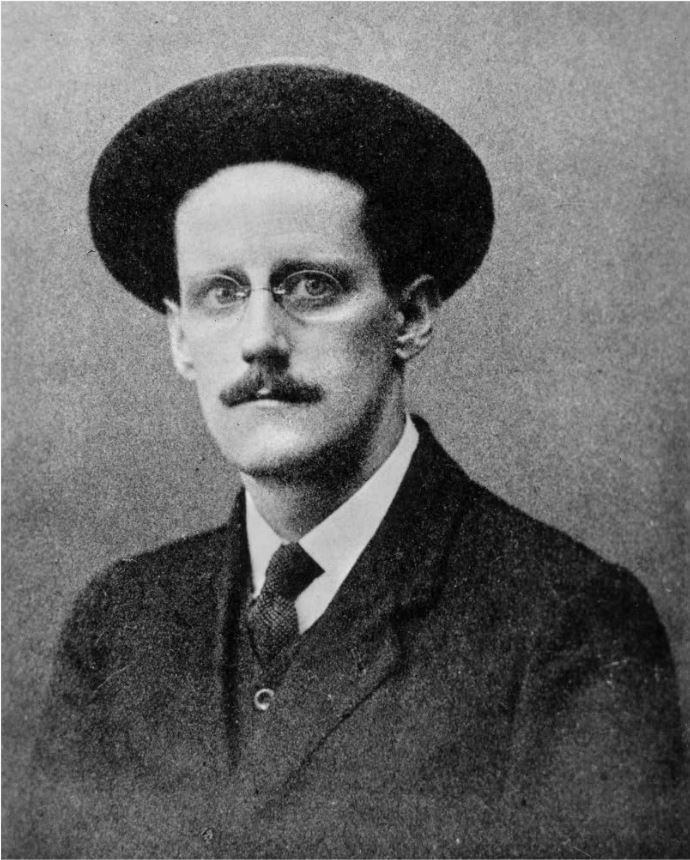Englische Matrosen im Oktober 1904 im Hafen von Triest > coll. Fototeca CMSA
1904
Ein schwieriger Start
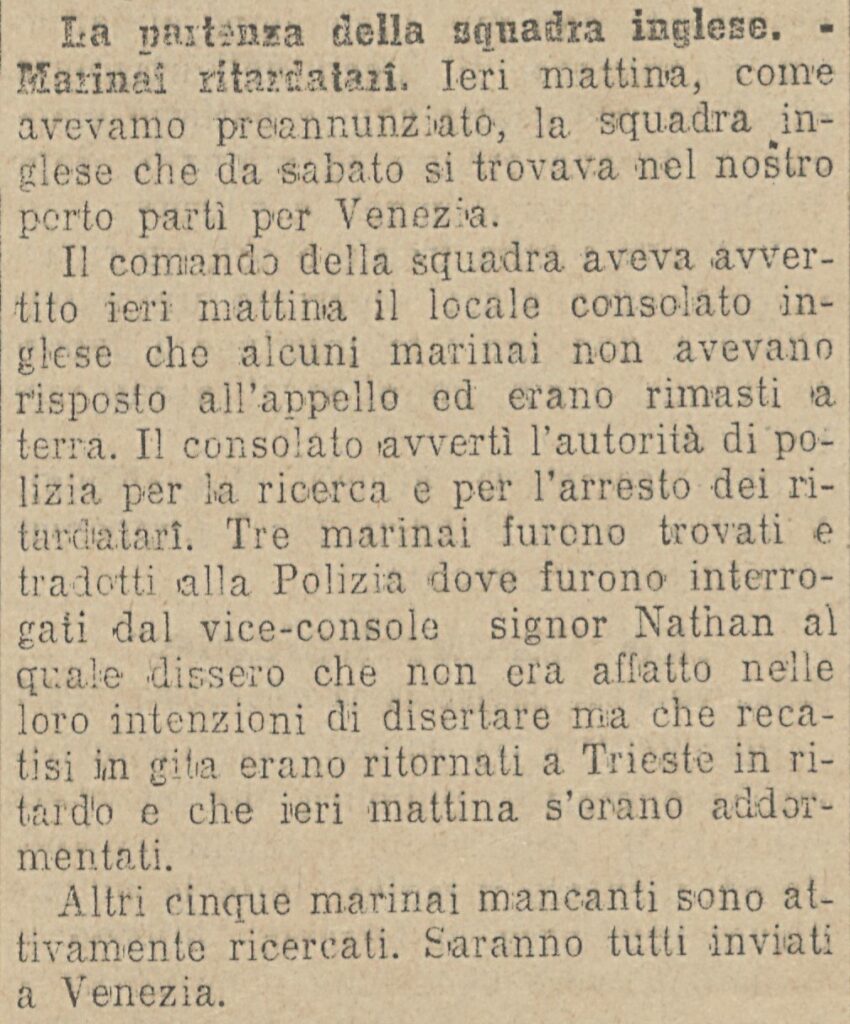
- Schaukästen
- Schaukästen
Pola/Pula, Ansicht des Stadtzentrums im frühen 20. Jahrhundert > coll. Museo Joyce – Fondo fotografico
1905
1907
«Unser schönes Triest»
Anfang März 1905 waren James und Nora zurück in Triest. Als am 27. Juli ihr erstes Kind Giorgio geboren wurde, hatten sie bereits eine Wohnung in der Via San Nicolò bezogen, ganz in der Nähe der Berlitz School. Am 26. Juli 1907 wurde Lucia geboren. Wie in Dublin, Pola/Pula, Zürich und Paris waren unvermittelte Wohnortwechsel eine Konstante im Leben von Joyce. Der Grund für diese Gewohnheit waren wirtschaftliche Schwierigkeiten und häufige Änderungen in der Familienkonstellation. Aber die Joyces bildeten hier keine Ausnahme: Im Triest der damaligen Zeit waren häufige Umzüge gang und gäbe, sogar jedes halbe Jahr war üblich.
Die Berlitz School befand sich neben dem römischen Bogen, der als Porta Aurea bekannt ist. Der Eindruck der istrischen Stadt, in der das österreichische Marinearsenal liegt, war nicht gerade der beste: Aufgrund der kalten, feuchten Wohnung und der eingeschränkten Unterhaltungsmöglichkeiten verglich Joyce die Stadt mit einer Art «Sibirien am Meer»
Im Herbst 1905 nahm Stanislaus Joyce, der zweite Sohn von John und May Joyce, die Einladung von James an und kam zu ihm nach Triest, wo er den Rest seines Lebens als beliebter Englischlehrer arbeiten sollte. Er spielte im Leben seines Bruders eine sehr wichtige Rolle. Im Jahr 1909 zogen auch seine Schwestern Eva und Eileen nach Triest.
- Schaukästen
- Schaukästen
Trieste - Gibraltar – Trieste
1939 veröffentlichte Herbert Gorman, Joyce’ Freund in Zürich, die erste, von Joyce selbst bestätigte und autorisierte Biografie des inzwischen berühmten Schriftstellers. Darin findet sich eine ausführliche Beschreibung von Triest. Die textlichen Entsprechungen zwischen Gormans Bild von Triest und Mollys Erinnerung an das Gibraltar ihrer Kindheit und Jugend in der letzten Episode des Ulysses sind zahlreich.
Und wenn einerseits klar ist, dass Mollys Gibraltar viel von Joyce’ Triest hat, so ist es andererseits so, als ob der Schriftsteller in den Jahren, in denen er Gorman bei der Abfassung der Biografie begleitete, bei der Erzählung von Triest den berühmten Schluss seines Meisterwerks vor Augen hatte.
HERBERT GORMANN, James Joyce, 1939
«Neue Geschichten für Dubliners wurden entworfen und dann verfasst. Und er tauchte in das vielfältige Leben von Triest ein, mit der Freude eines Delfins, der in vertrauten Gewässern schwimmt. Jeder Aspekt der Stadt schien ihm zu gefallen, das malerische Leben entlang der Kais, die vielfältigen Wege der Città Vecchia mit ihren Weinläden und billigen Restaurants, die Ochsenkarren, die durch die Straßen rumpelten, die ständigen Prozessionen, bei denen rote Decken aus den Fenstern hingen und Kerzen dahinter schimmerten, die Albaner in einheimischen Trachten und die fulminant verschleierten Frauen – denn keine von ihnen trug einen Hut – beim Verlassen der Theater, die unzähligen Fässer mit Kaffee vor den Geschäften, deren üppiger Geruch die Luft erfüllte, die riesigen Wassermelonen, die auf den Plätzen gestapelt waren und deren purpurrote Saftigkeit bis zwei oder drei Uhr morgens in flackernden Lichtern erstrahlte, die sonntäglichen Müßiggänger, die Boccia oder Mora spielten, […] das backenbärtige Bildnis von Kaiser Franz Joseph in weißer Tunika, das jeden Tabakladen schmückte, der riesige gepuderte Türsteher an der Oper, der nach Kutschen rief, und die drei Spielzeiten der Oper selbst – die Weihnachts- und Karnevalszeit im Teatro Comunale und die Sommersaison im Freilichttheater und die Herbstsaison im Politeama, das aufgeregte Geplapper von Käufern und Verkäufern auf den Märkten, denn es gab keine festen Preise, der Geruch von Fisch und der Anblick von Seespinnen, die in ihren Schalen gekocht wurden, die unzähligen Tavernen mit christlichen Namen und vor allem die Triester, wohltätig, witzig, irreligiös, skeptisch, kuchenliebend und dem “schwarzen Wein” aus Istrien und dem Likör-Roséwein – dem Opollo aus Lissa – zugeneigt. Selbst die “Bora”, dieser schreckliche Wind, der so heftig durch die Stadt blies, dass Seile an den Straßen gespannt werden mussten, um den Fußgängern zu helfen, faszinierte ihn als unwiderstehliches Naturphänomen. Viele Jahre später bemerkte er gegenüber einem Freund: “Ich kann Ihnen nicht einmal ansatzweise einen Eindruck vom alten österreichischen Kaiserreich vermitteln. Es war eine wackelige Angelegenheit, aber es war charmant, fröhlich, und ich habe in Triest mehr Freundlichkeit erfahren als je zuvor bzw. danach in meinem Leben … Vergangene Zeiten kehren nicht wieder, aber ich wünschte, sie wären zurück.”»
Übersetzung von Matthias Probst
JAMES JOYCE, Ulysses, 'Penelope' 1580-1600
«…und zuerst hab ich gar keine Antwort gegeben hab bloß so rausgeschaut aufs Meer und über den Himmel ich musste an so viele Sachen denken von denen er gar nichts wusste Mulvey und Mr Stanhope und Hester und Vater und der alte Captain Groves und die Matrosen die alle Vögel fliegen hoch und ich ruf bückt euch und Geschirrspülen wie sie das nannten spielten am Pier und die Wache vor dem Haus des Gouverneurs mit dem runden Ding um den weißen Helm der arme Teufel halb gebraten war er und die spanischen Mädchen wie sie immer am lachen waren in ihren Schals und mit den großen Kämmen und die Versteigerungen morgens immer die Griechen und Juden und Araber und weiß der Teufel wer sonst noch alles von allen Enden Europas und die Duke Street und der Geflügelmarkt wie da alles am gackern war vor Larby Sharon und die armen Eselchen wie die halb im Schlaf da langschlichen und die Gammelbrüder mit den Mänteln die auf den Treppenstufen schliefen im Schatten und die großen Räder der Ochsenkarren und das alte Schloss tausende von Jahren alt schon ja und die hübschen Mauren alle ganz in weiß und mit Turbanen wie Könige wie sie einen baten man soll doch Platz nehmen in ihren winzig kleinen Lädchen und Ronda mit den alten Fenstern der posadas hinterm Gitter zweier Augen Glanz für ihren Liebhaber dass er das Eisen küsst und die Weinhandlungen die immer halb offen hatten nachts und die Kastagnetten und an dem Abend wo wir das Fährschiff in Algeciras verpasst hatten der Wächter wie er so heiter und alles in Ordnung herumging mit seiner Laterne und oh der reißend tiefe Strom oh und das Meer das Meer glührot manchmal wie Feuer und die herrlichen Sonnenuntergänge und die Feigenbäume in den Alamedagärten ja und die ganzen komischen kleinen Straßen und Gässchen und rosa und blauen und gelben Häuser und die Rosengärten und der Jasmin und die Geranien und Kaktusse und Gibraltar als kleines Mädchen wo ich eine Blume des Berges war ja wie ich mir die Rose ins Haar gesteckt hab wie die andalusischen Mädchen immer machten oder soll ich eine rote tragen ja und wie er mich geküsst hat unter der maurischen Mauer und ich hab gedacht na schön er so gut wie jeder andere und hab ihn mit den Augen gebeten er soll doch nochmal fragen ja und dann hat er mich gefragt ob ich will ja sag ja meine Bergblume und ich hab ihm zuerst die Arme um den Hals gelegt und ihn zu mir niedergezogen dass er meine Brüste fühlen konnte wie sie dufteten ja und das Herz ging ihm wie verrückt und ich hab ja gesagt ja ich will Ja.»
Übersetzung von Hans Wollschläger
1907
1912
Journalist, Redner, Unternehmer
Nach acht unbefriedigenden Monaten in Rom als Korrespondent in einer Bank kehrte Joyce nach Triest zurück. Italo Svevo wurde sein Schüler, ebenso wie der Journalist Roberto Prezioso, der ihn um eine Reihe von Artikeln über Irland für die Zeitung “Piccolo della Sera” bat. Die anspielungsreiche Parallele zwischen dem von den Briten unterdrückten Irland und dem von den Österreichern unterdrückten Triest faszinierte die irredentistischen Leser. Eine Konferenz, die er – auf Einladung von Attilio Tamaro, einem seiner Studenten – an der Università Popolare hielt, befasste sich ebenfalls mit Irland, einer Insel der Heiligen und Weisen. Auch zu anderen Themen wurden Konferenzen organisiert, in erster Linie zu Shakespeare. Bei der Ankündigung hatte die lokale Presse offensichtlich Schwierigkeiten mit dem spelling eines Namens, der zu “James Joice”, “James Zois”, “Jame Yoyce” bzw. “Zanus Joyce” wurde. In Ulysses wird sogar der Name Leopold Bloom regelmäßig und auf komische Weise verunstaltet.
Eines der ungewöhnlichsten triestinischen Abenteuer von Joyce war die Eröffnung des ersten Kinos in Dublin im Jahr 1909. Das Volta wurde von einer Gruppe triestinischer Unternehmer finanziert und scheiterte in weniger als einem Jahr. Ebenso enttäuschend war sein Vorhaben, irischen Tweed in Triest zu verkaufen, eine Idee, die ihm 1909 in Dublin kam.
- Schaukästen
- Schaukästen

1912
1920
«Tergestis exul»
Das Leben im Hause Joyce war nicht einfach: Spannungen mit Stanislaus und seinen Schwestern, mit dem Verleger von Dubliner; die mühsame Abfassung von Ein Portrait, Giacomo Joyce und Verbannte; Geldmangel, Zwangsräumungen… bis Stannie im September 1912 eine Wohnung in der Via Bramante 4 für seinen Bruder fand. So begann eine relativ lange und friedliche Zeit: Der Schriftsteller fingt an, die ersten drei Episoden von Ulysses zu schreiben, doch der Krieg zwang den “britischen” Joyce, Triest zu verlassen (Stannie wurde verhaftet und in Österreich interniert). Im Jahr 1915 zog die Familie nach Zürich und kehrte im Oktober 1919 nach Triest zurück, um sich mit Stanislaus, Eileen und ihrem Mann in einer überfüllten Wohnung in der Via Sanità 2 wieder zu vereinen. Hier setzt Joyce die Arbeit an Ulysses fort, wobei er hauptsächlich an “Nausicaa”, “Ochsen der Sonne” und “Circe” arbeitete. Im Juli 1920 zog er auf Einladung von Ezra Pound nach Paris. Er sollte nie wieder nach Triest zurückkehren.
- Schaukästen


